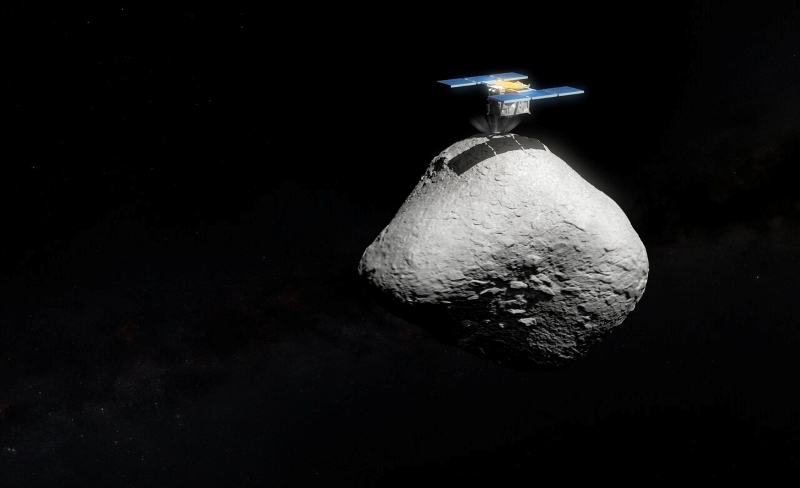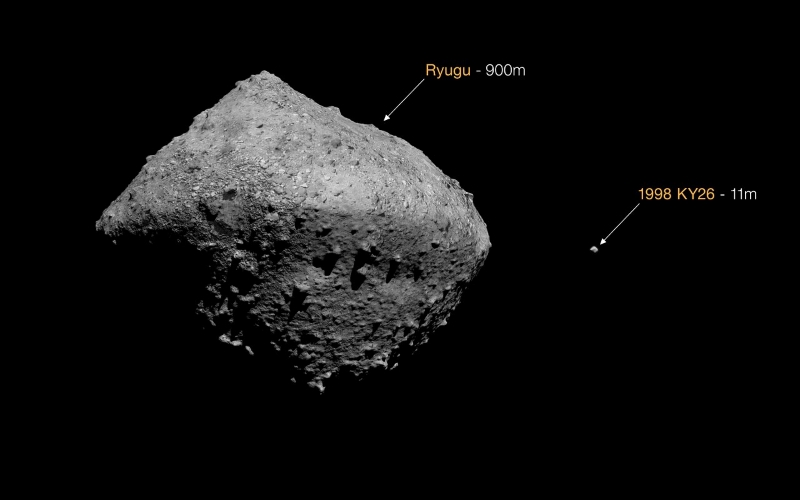Now Reading: Trouble for Hayabusa2? Asteroid target smaller than expected
-
01
Trouble for Hayabusa2? Asteroid target smaller than expected
Trouble for Hayabusa2? Asteroid target smaller than expected


Hayabusa2’s target asteroid is smaller and spinning faster than once thought
New observations of asteroid 1998 KY26, the next target of Japan’s Hayabusa2 spacecraft, reveal the space rock to be almost three times smaller and spinning much faster than previously thought. Hayabusa2 is scheduled to touch down on the asteroid in 2031. This is part of the spacecraft’s extended mission following its touchdown on asteroid Ryugu in 2018.
Astronomer Toni Santana-Ros, who led the study on 1998 KY26, said:
We found that the reality of the object is completely different from what it was previously described as.
The new observations, combined with previous radar data, reveal that the asteroid is just 11 meters wide. This means it could easily fit inside the dome of the Very Large Telescope (VLT) unit telescope used to observe it. It is also spinning about twice as fast as previously thought. One day on the asteroid lasts only 5 minutes. Previous data indicated that the asteroid was around 30 meters (98 feet) in diameter and completed a rotation in around 10 minutes.
Co-author Olivier Hainaut said:
The smaller size and faster rotation now measured will make Hayabusa2’s visit even more interesting, but also even more challenging.
This is because a touchdown maneuver, where the spacecraft ‘kisses’ the asteroid, will be more difficult to perform than anticipated.
The researchers published the study in the peer-reviewed journal Nature Communications on September 18, 2025.
The final target of Hayabusa2
1998 KY26 is set to be the final target asteroid for the Japanese Aerospace eXploration Agency (JAXA)’s Hayabusa2 spacecraft. In its original mission, Hayabusa2 explored the 900-meter-diameter asteroid 162173 Ryugu in 2018. It returned asteroid samples to Earth in 2020.
With fuel remaining, the spacecraft was sent on an extended mission until 2031. That’s when it’s set to encounter 1998 KY26, aiming to learn more about the smallest asteroids. This will be the first time a space mission encounters a tiny asteroid. All previous missions have visited asteroids with diameters in the hundreds or even thousands of meters.

New observations
Santana-Ros and his team observed 1998 KY26 from the ground to support preparation for the mission. Because the asteroid is very small and, hence, very faint, studying it required waiting for a close encounter with Earth and using a number of large telescopes around the world, including ESO’s Very Large Telescope (VLT) in Chile’s Atacama Desert.
The observations show that the asteroid has a bright surface and likely consists of a solid chunk of rock, which might have originated from a piece of a planet or another asteroid. However, the team could not completely rule out the possibility that the asteroid is made up of rubble piles loosely sticking together.
Santana-Ros said:
We have never seen a 10-meter-size asteroid in situ, so we don’t really know what to expect and how it will look. The amazing story here is that we found that the size of the asteroid is comparable to the size of the spacecraft that is going to visit it! And we were able to characterize such a small object using our telescopes, which means that we can do it for other objects in the future. Our methods could have an impact on the plans for future near-Earth asteroid exploration or even asteroid mining.
Hainaut added:
Moreover, we now know we can characterize even the smallest hazardous asteroids that could impact Earth, such as the one that hit near Chelyabinsk, in Russia in 2013, which was barely larger than KY26.
Bottom line: New observations of the asteroid that Hayabusa2 is scheduled to touch down on in 2031 reveal it’s smaller and spinning much faster than once thought.
The post Trouble for Hayabusa2? Asteroid target smaller than expected first appeared on EarthSky.
Stay Informed With the Latest & Most Important News
-
 01From Polymerization-Enabled Folding and Assembly to Chemical Evolution: Key Processes for Emergence of Functional Polymers in the Origin of Life
01From Polymerization-Enabled Folding and Assembly to Chemical Evolution: Key Processes for Emergence of Functional Polymers in the Origin of Life -
 02Two Black Holes Observed Circling Each Other for the First Time
02Two Black Holes Observed Circling Each Other for the First Time -
 03How New NASA, India Earth Satellite NISAR Will See Earth
03How New NASA, India Earth Satellite NISAR Will See Earth -
 04Thermodynamic Constraints On The Citric Acid Cycle And Related Reactions In Ocean World Interiors
04Thermodynamic Constraints On The Citric Acid Cycle And Related Reactions In Ocean World Interiors -
 05Φsat-2 begins science phase for AI Earth images
05Φsat-2 begins science phase for AI Earth images -
 06Hurricane forecasters are losing 3 key satellites ahead of peak storm season − a meteorologist explains why it matters
06Hurricane forecasters are losing 3 key satellites ahead of peak storm season − a meteorologist explains why it matters -
 07Binary star systems are complex astronomical objects − a new AI approach could pin down their properties quickly
07Binary star systems are complex astronomical objects − a new AI approach could pin down their properties quickly



















